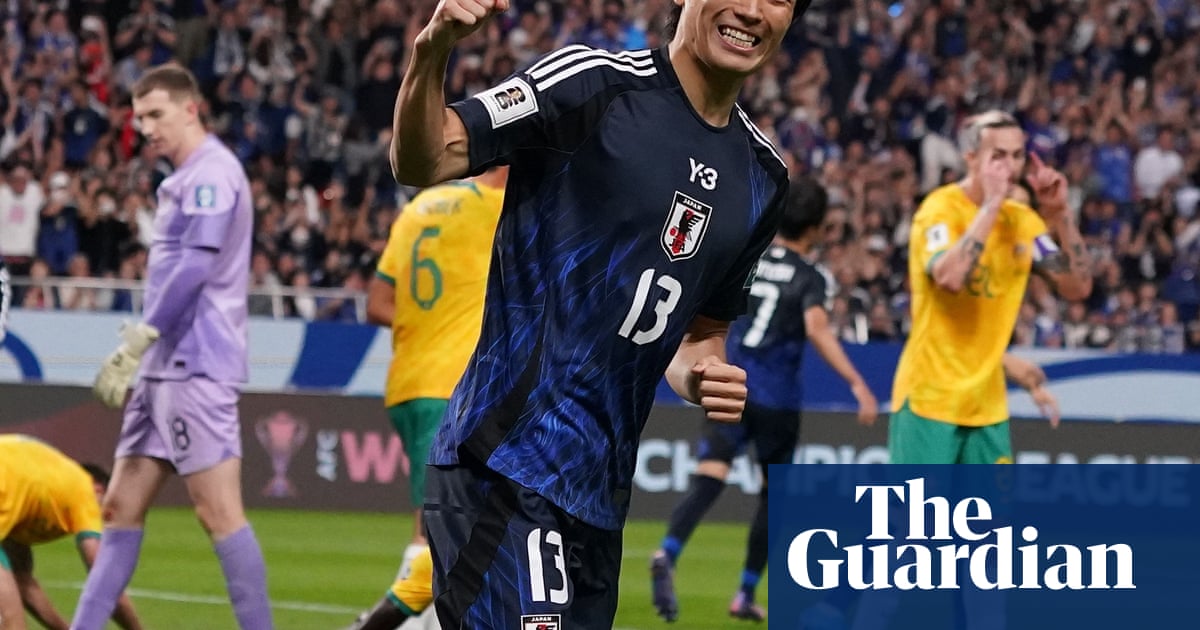The road to North America lies through Western Australia, and the hope for the Socceroos is that it doesn’t all go south against their rivals from East Asia. A win against Japan in Perth on Thursday would almost certainly be enough for coach Tony Popovic’s side totake the second automatic spot in their 2026 World Cup qualifier group. The good news is that there has never been a better time to face a Samurai Blue side that hasalready qualifiedand is in experimental mode. The bad news is … well, that is for Saudi Arabia to deal with.
Having dominated Group C – being the first to book a berth in the newly-expanded 48-team tournament and boasting a goal difference of plus-46 in 14 qualifiers so far – Japan have earned the right to bring a squad containing just seven players with more than 10 international caps to Australia. They have also cemented their reputation as a genuine global force. After clinching their spot against Bahrain in March, captain Wataru Endo – one of the few established stars to make this trip – said that it was time to think about winning theWorld Cup. In 2005, the Japan Football Association pledged to do so by 2050. People laughed at the time, but to wait that long now would be a little disappointing.
That was around the time whenAustraliajoined the AFC and now, the situation with the two teams is all but reversed. Japan are full of stars playing in the big leagues. Endo has just won the Premier League title with Liverpool, Kaoru Mitoma is reportedly wanted by Arsenal and Bayern Munich and is set to take the title of Asia’s biggest star from Son Heung-min. Ao Tanaka of newly-promoted Leeds United was, for many, the best player in the this season’s Championship.
Fans in Perth would usually love the rare chance to see such European-based talent but both Mitoma and Tanaka are absent. Indeed, many of Japan’s European stars have been allowed by coach Hajime Moriyasu to go on holiday – including the likes of Ritsu Doan of SC Freiburg, Monaco’s Takumi Minamino, Hidemasa Morita of Sporting, Borussia Monchengladbach’s Ko Itakura. In total, just 13 of the 27 players who made March’s squad will be in Perth.
“I have always tried to make changes,” said Moriyasu, who has been in charge since 2018. “In my opinion, it is not so much that we are selecting them, but rather that they have been proving themselves with performances that are worthy of selection.” Ryunosuke Sato, for example, is just 18 years old but has impressed as wing-back on loan at Fagiano Okayama. Junnosuke Suzuki, a 21-year-old converted centre-back also looks to have a bright future. Shunsuke Mito is another newbie, as is fellow Netherlands-based star Kodai Sano who joins his brother and FC Mainz player Kaishu. It is testament to the coach’s leadership that while Japan are a settled and stable side with a firm identity, he has also selected over 60 players since the 2022 World Cup.
Given what is at stake for the hosts, few in Australia will care if their opponents are not at their strongest. There are, however, concerns in Saudi Arabia, who are three points behind the Socceroos with a much inferior goal difference, and in need of a favour. There was an assumption in Riyadh that Japan would get at least a draw in Perth to ensure that Hervé Renard’s side would hold the top-two destiny in their own hands, with the shortest of trips to Bahrain followed by a home game against a travel-weary Socceroos five days later. After Moriyasu named his squad, confidence in Riyadh has taken a dent. The Chinese media have also discussed Moriyasu’s choices as they are counting on the Blues to beat Indonesia, rivals for the top four, at home on Tuesday.
Sign up toFootball Daily
Kick off your evenings with the Guardian's take on the world of football
after newsletter promotion
While Japan may still play Moriyasu’s favoured 3-4-2-1 formation, given all the changes, it is hard to know who starts and who does not. Moriyasu said that the rookies need some veterans around them. Endo should be in the middle, perhaps behind the more creative talents of Takefusa Kubo, who had a good season with Real Sociedad and Daichi Kamada who helped Crystal Palace win the FA Cup. Left-back Yūto Nagatomo, provider of the decisive cross for the 2011 Asian Cup’s winning goal, may inch closer to his 150th cap, not much fewer than the other 26 have between them.
There may be some issues for the Australian coaching staff to try and prepare for a game against a potentially unfamiliar foe but this has to be better than facing the strongest version of Japan desperate for points. That there is still plenty of talent does not need to be said, the same with warnings against complacency – the new players have a chance to play themselves into contention for the World Cup – but there is no doubt that Japan are in Perth with more than one eye on the next northern summer.
